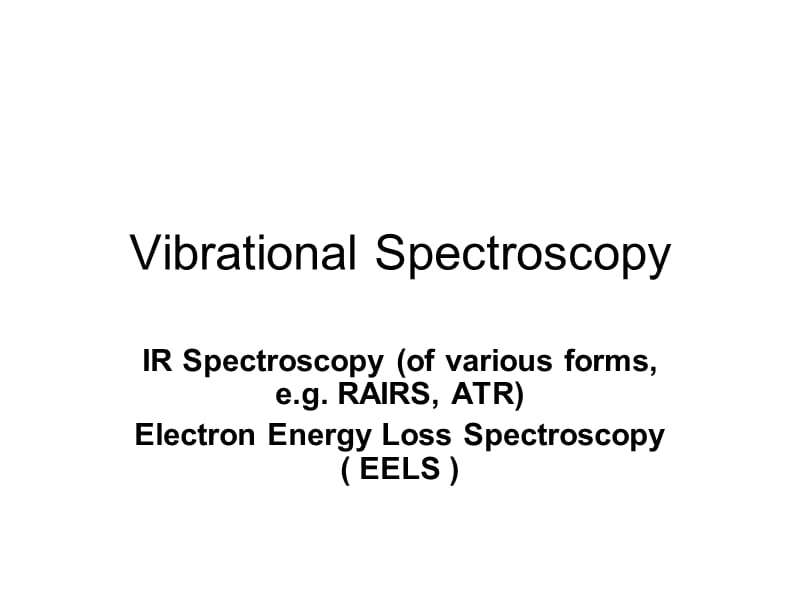《VibrationalSpectroscopy-NUIGalwayNationalUniversityof振動光譜-高威國立大學(xué)》由會員分享���,可在線閱讀�����,更多相關(guān)《VibrationalSpectroscopy-NUIGalwayNationalUniversityof振動光譜-高威國立大學(xué)(13頁珍藏版)》請在裝配圖網(wǎng)上搜索�。
1、Vibrational Spectroscopy,IR Spectroscopy (of various forms, e.g. RAIRS, ATR) Electron Energy Loss Spectroscopy ( EELS ),IR Spectroscopy,Transmission IR Spectroscopy : studies where large surface area permits high concentration of adsorbed species. Diffuse Reflectance IR Spectroscopy ( DRIFTS ) : dif
2��、fusely scattered IR collected, refocused and analysed. Employed with high surface area samples not sufficiently transparent to be studied in transmission. Reflection-Absorption IR Spectroscopy ( RAIRS ) : IR specularly reflected from front face of a highly-reflective sample, such as a metal single c
3����、rystal surface. Multiple Internal Reflection Spectroscopy ( MIR ) : IR passed through IR transmitting sample and undergoes total internal reflection. IR radiation may be absorbed by species adsorbed on the solid surface - alternative name of Attenuated Total Reflection (ATR).,RAIRS,Because sensitivi
4、ty in detecting sub-monolayer coverages can be problematic in RAIRS, use grazing incidence geometry,RAIRS,surface selection rule only those vibrational modes which give rise to an oscillating dipole perpendicular (normal) to the surface are IR active and give rise to an observable absorption band.,S
5����、urface selection rule,Vibration of a polar molecule oriented parallel to the substrate surface induces an image charge in the surface that cancels out the dipole, whereas it is enhanced for vibrations perpendicular to the surface (see p. 80 Attard the n(H-CN) mode is seen at 3302 cm-1 but the n(C-N)
6、 mode is too weak to be seen and the d(HCN) mode expected at ca. 850 cm-1 is forbidden by the surface selection rule. The overtone of the bending mode, 2d(HCN), is however allowed and is evident at ca. 1580 cm-1. (b) 1.50 L HCN at 100 KHigher exposures lead to the physisorption of HCN molecules into
7���、 a second layer. These molecules are inclined to the surface normal and the HCN bending mode ( 820 cm-1) of these second layer molecules is no longer symmetry forbidden. Hydrogen bonding between molecules in the first and second layers also leads to a noticeable broadening of the n(H-CN) band to low
8�����、er wavenumbers.(c) 30 L HCN at 200 KAt the higher temperature of 200 K only a small amount of molecular HCN remains bound in an end-on fashion to the surface. The relatively strong band at 2084 cm-1 suggests that some dissociation has also occurred to give adsorbed CN groups, which give rise to a ma
9��、rkedly more intense n(C-N) band than the HCN molecule itself.,CO on Cu,FT-RAIRS spectra of CO/Cu(100). (Adapted from J.C. Cook, S.K. Clowes and E.M. McCash, J. Chem. Soc. Faraday Trans 93 (1997) 2315) (a) Adsorption at 23 K showing both monolayer chemisorbed CO peak and multilayered physisorbed CO.
10����、(b) Effect of warming to 26 K to desorb multilayers, leaving a single physisorbed monolayer. (c) Effect of warming to 35 K and recooling to 23 K. (d) Surface described in c following further adsorption of CO at 23 K. 128 co-added scans.,CO on Pt,,,EELS/HREELS,EELS can be applied with several techniq
11�、ues, but always involves the bombardment of a sample with a monoenergetic beam of electrons. The technique is frequently used in association with Transmission Electron Microscopy (TEM) or Scanning TEM (STEM). By examining energy losses at high resolution (about 30 meV), as in HREELS, data concerning
12、 the vibrations of molecules on surfaces can be determined. Hence HREELS provides complementary information to RAIRS,RAIRS and HREELS,HREELS examples,A HREELS spectrum of CO on Rh(111) (taken from G. A. Somorjai, Introduction to Surface Chemistry and Catalysis, Wiley Interscience, New York (1994)) is shown in Fig. 6.32. The feature at 500 wavenumbers arises from the C-metal stretching vibration whereas the two features at 2000 wavenumbers are derived from C-O stretches.,CO on Pt,
 VibrationalSpectroscopy-NUIGalwayNationalUniversityof振動光譜-高威國立大學(xué)
VibrationalSpectroscopy-NUIGalwayNationalUniversityof振動光譜-高威國立大學(xué)

